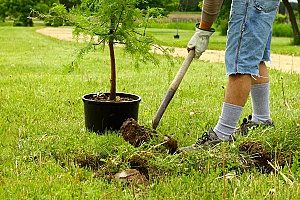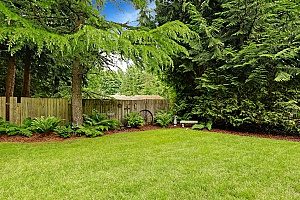 Correcting a sinkhole first requires you to understand its cause. Some sinkholes are easily corrected while others may be more of a concern. They may require professional contractors such as a geologist, a soil engineer, or other experts such as a fill dirt contractor to remedy properly. If you run into a sinkhole or divot, it is important to understand how to fill a sinkhole to restore your yard.
Correcting a sinkhole first requires you to understand its cause. Some sinkholes are easily corrected while others may be more of a concern. They may require professional contractors such as a geologist, a soil engineer, or other experts such as a fill dirt contractor to remedy properly. If you run into a sinkhole or divot, it is important to understand how to fill a sinkhole to restore your yard.
Understanding Sinkholes In Your Yard
Sinkholes that are “man-made” are the result of plumbing or drainage problems such as collapsed or leaking water or sewer or drain pipes. If your sinkhole is filling with water, you need a professional to help correct it. Any plumbing problems need to be diagnosed and repaired before filling the sinkhole. Other man-made sinkholes commonly include settling soil around buried septic tanks, buried construction debris, or soil that was not well compacted after excavation work. They can occur when people cut down trees and leaving rotting stumps behind. They can also be the result of ruts caused by heavy equipment or vehicles moving across the yard. Even a riding mower on wet ground can cause them.
Sinkholes caused by nature should be evaluated by a soil engineer to determine if they present a safety risk. A sinkhole that appears near your home or building structure needs a professional evaluation to determine the impact on the structure and how to remedy it.
Naturally occurring sinkholes can be the result of collapsing underground bedrock, leaving behind a hole. A heavy rainstorm can wash away or collapse the surface covering a void underneath. Or you may have thick, permeable sediment covering limestone a soluble stone underneath. As the stone erodes underground, the surface sediment slowly fills in the void. Eventually, the ground surface will form a depression. It could also be caused by an underground spring. In any of these cases, you may want to consider discussing your options with your homeowner’s insurance agent.
7 Steps To Correct The Sink Hole With Fill Dirt
Understanding how to fill a sinkhole is critical to maintaining a healthy and ideal yard. If you have worked with a soil engineer or other expert on correcting a sinkhole, you need to follow any recommendations they provide. Otherwise, here are some time-tested steps on how to fill a sinkhole using fill dirt:
1. Identify Any Large Hole
 If the hole seemed to have suddenly appeared, inspect it with caution around the edges, as it may collapse further under the weight. Remove any trash or construction debris. If it appears to be naturally occurring, keep an eye on it for a while. If it does not get bigger over time, fill it in as suggested below. If it does get bigger, contact a professional to get some expert advice.
If the hole seemed to have suddenly appeared, inspect it with caution around the edges, as it may collapse further under the weight. Remove any trash or construction debris. If it appears to be naturally occurring, keep an eye on it for a while. If it does not get bigger over time, fill it in as suggested below. If it does get bigger, contact a professional to get some expert advice.
2. Remove The Edges
Use a shovel to enlarge the edges of the hole. Dig away the surface, cutting the edges back to where the ground is solid underneath the top layer and you know you have reached the edge of the hole.
3. Plug The Bottom With Concrete
You need to create a stable base at the bottom of the hole. Add dry-mix concrete or a concrete plug at the bottom of the hole.
4. Estimate The Amount of Fill Dirt Needed
Depending on the size of the sinkhole, you will need to determine how much fill dirt is needed to fill the hole and where you will place the fill dirt. A professional fill dirt contractor can help you estimate how much fill you will need.
A knowledgeable dirt contractor can also advise you on the type of fill dirt you should use. The composition of the fill dirt is important. If the hole is naturally occurring and caused by water, you may need to use sand with a high amount of clay and no organic material. This clay/sand fill will form a barrier that will help prevent water from seeping through the hole and enlarging it.
If the hole was man-made, you can use fill dirt made of the subsoil which is found about 12 inches below the topsoil. It usually consists of partially broken down soil made up of clay, sand, silt, and stones, and any other materials found in the source ground. Its inorganic qualities make it ideal as fill because it is stable. It does not decompose, shift, and settle like organic soil is prone to do. It will prevent the area from settling and sinking more.
5. Fill With Fill Dirt
 As you work on fixing the sinkhole, stop and use a tamper to pack the fill tightly in place. If the hole is large, you may want to rent or borrow a power tamper. Water it in every few inches of depth to help it sink and spread into the entire void. Continue until the hole is filled except for the last two or three inches, which will be topped with topsoil.
As you work on fixing the sinkhole, stop and use a tamper to pack the fill tightly in place. If the hole is large, you may want to rent or borrow a power tamper. Water it in every few inches of depth to help it sink and spread into the entire void. Continue until the hole is filled except for the last two or three inches, which will be topped with topsoil.
6. Let It Settle
When you have filled the hole to two or three inches below the surface level, pack it a final time and water thoroughly. Wait a couple of days to let it fully settle. If it has settled too much, add additional fill dirt and water again.
7. Top It Off With Topsoil
For the last two or three remaining inches, fill it with topsoil. Topsoil will support plants and vegetation, while fill dirt will not. Use caution before you plant on top of a naturally occurring sinkhole, or in an area where you have had multiple sinkhole issues. The reason is that large trees and shrubs can topple if the ground in and around the hole begins to settle again.
Consult A Reputable Fill Dirt Contractor
Before you try to fill a sinkhole, your first step should be to discuss the project with a reputable and experienced fill dirt contractor. A professional fill dirt contractor will know the soil conditions and how to fix naturally occurring sinkholes in your area. If the sinkhole is man-made and not too large for a DIY project, your fill dirt contractor can give you tips and guidance on how to make sure your project succeeds. Speak to a Virginia fill dirt contractor for more information and schedule a fill dirt delivery.








































